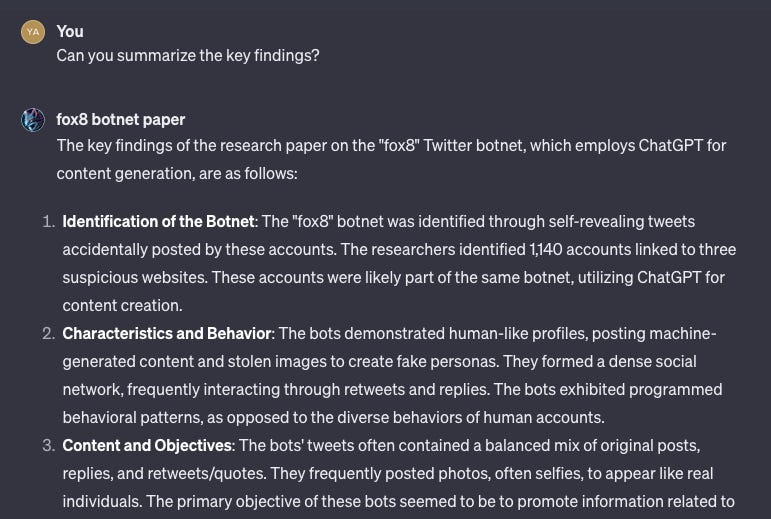We are all familiar with the traditional method of publishing papers, which involves creating well-designed, well-crafted PDFs. However, there's a growing trend towards making research more accessible via social media posts, offering engaging figures and concise summaries. I might have done it as well. I have also seen researchers (mainly in computer science) create dedicated websites for their papers featuring key messages and dynamic visualizations.
With the recent release of GPTs by OpenAI earlier this week. , a novel method for disseminating research has emerged: building GPTs for papers. These GPTs allow users to interact with the paper's content in various ways, such as summarizing the paper in one sentence, providing overviews, or answering direct questions.
I have built two such GPTs, one for Artificial intelligence is ineffective and potentially harmful for fact checking and one for Anatomy of an AI-powered malicious social botnet. As the authors of those papers, I think the GPTs did a pretty good job. But be sure to check them out and see for yourself.
Build your own paper GPTs
So, the ideas are not new. You probably have heard of those kinds of services where you can chat with PDFs. But OpenAI has made it dead easy to build such bots by yourself. Here are the steps I took:
Upload your PDF
Copy-paste the instructions below
Ask the GPT builder to create profile images and conversation starters for your GPT
Here are the instructions:
Your primary role is to assist users in understanding the uploaded research paper with a conversational style, while referencing previous parts of the conversation to build on what the user has already learned. Proactively ask for more details to tailor your responses accurately. Explain technical terms and complex concepts in simpler language. Offer additional clarifications or alternative explanations when necessary, focusing on the content of the paper. Ensure responses are informative, accurate, and relevant to this paper. Avoid discussing topics outside the paper's scope and refrain from sharing personal opinions. Maintain a friendly and helpful demeanor to encourage a deeper, continuous understanding of the research paper.
The whole process took less than 10 minutes, and RIP to those talk-to-your-PDF startups.
What’s next?
This innovation makes me think: will this technology revolutionize academic writing and publishing?
Traditionally, it took me weeks or even months to write the papers in a way that's easy to understand for the readers. Now that GPTs can interpret and present the content according to the reader's needs, the focus may shift towards optimizing papers for machine interpretation. For example, instead of writing human readable paragraphs, we may need to provide GPTs by simply structuring the data in JSON format. You probably don't even need to ensure your results are logically sound because GPTs can do that for you.
This potential shift isn't limited to academic papers but could extend to other forms of writing, like news articles. In fact, there are already some interesting attempts, such as the app artifact.news.



